Visualization Designs
VerifiedAdded on 2023/01/19
|7
|1700
|81
AI Summary
This document discusses various types of visualization designs such as text visualization, rain radar graphical visualization, spatial versus non-spatial visualization, scientific versus information visualization, continuous versus discrete data visualization, and nominal or ordinal visualization. It also explores the use of filters, groups, and sets in visualization. The data provided includes examples and explanations for each type of visualization.
Contribute Materials
Your contribution can guide someone’s learning journey. Share your
documents today.
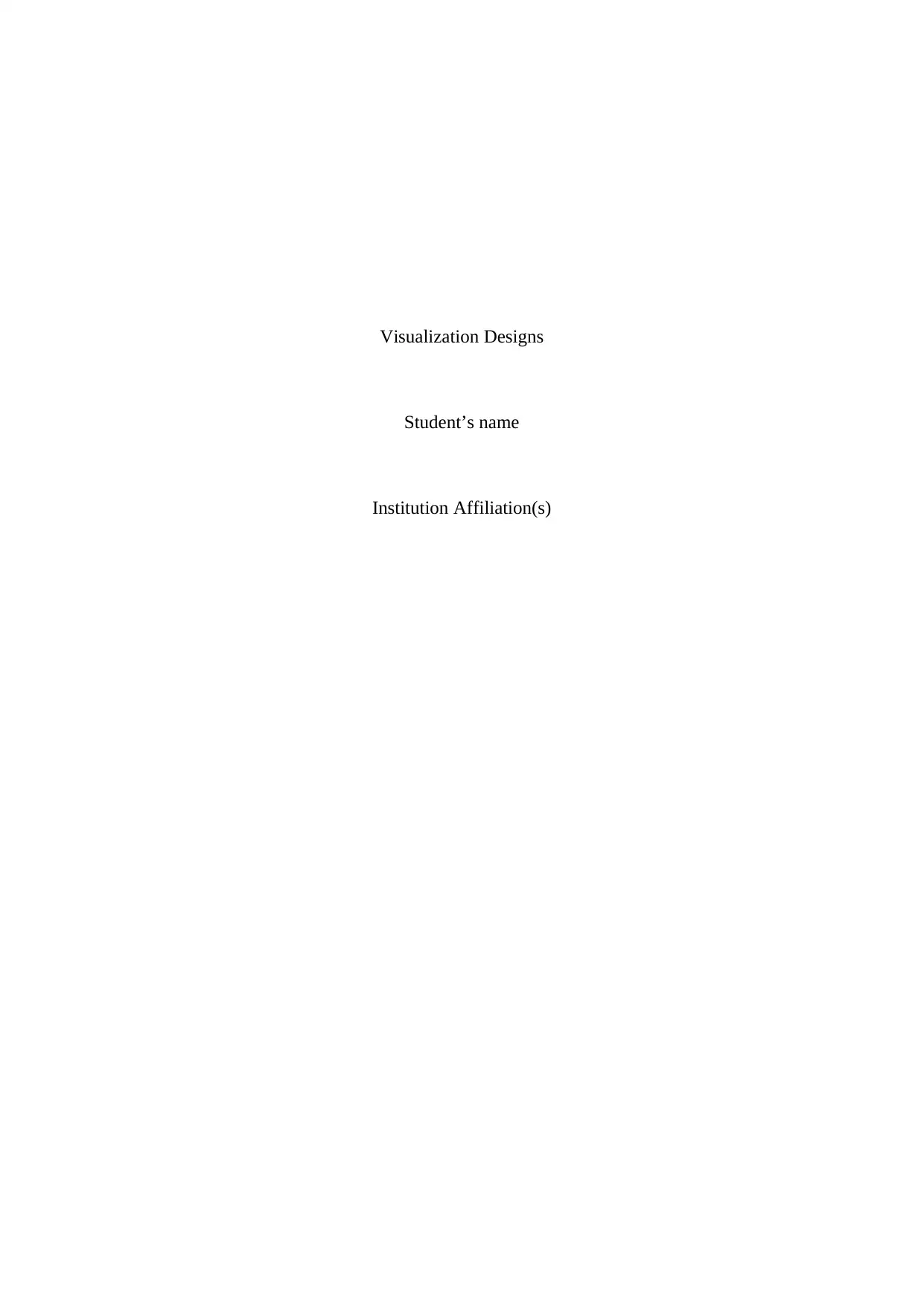
Visualization Designs
Student’s name
Institution Affiliation(s)
Student’s name
Institution Affiliation(s)
Secure Best Marks with AI Grader
Need help grading? Try our AI Grader for instant feedback on your assignments.
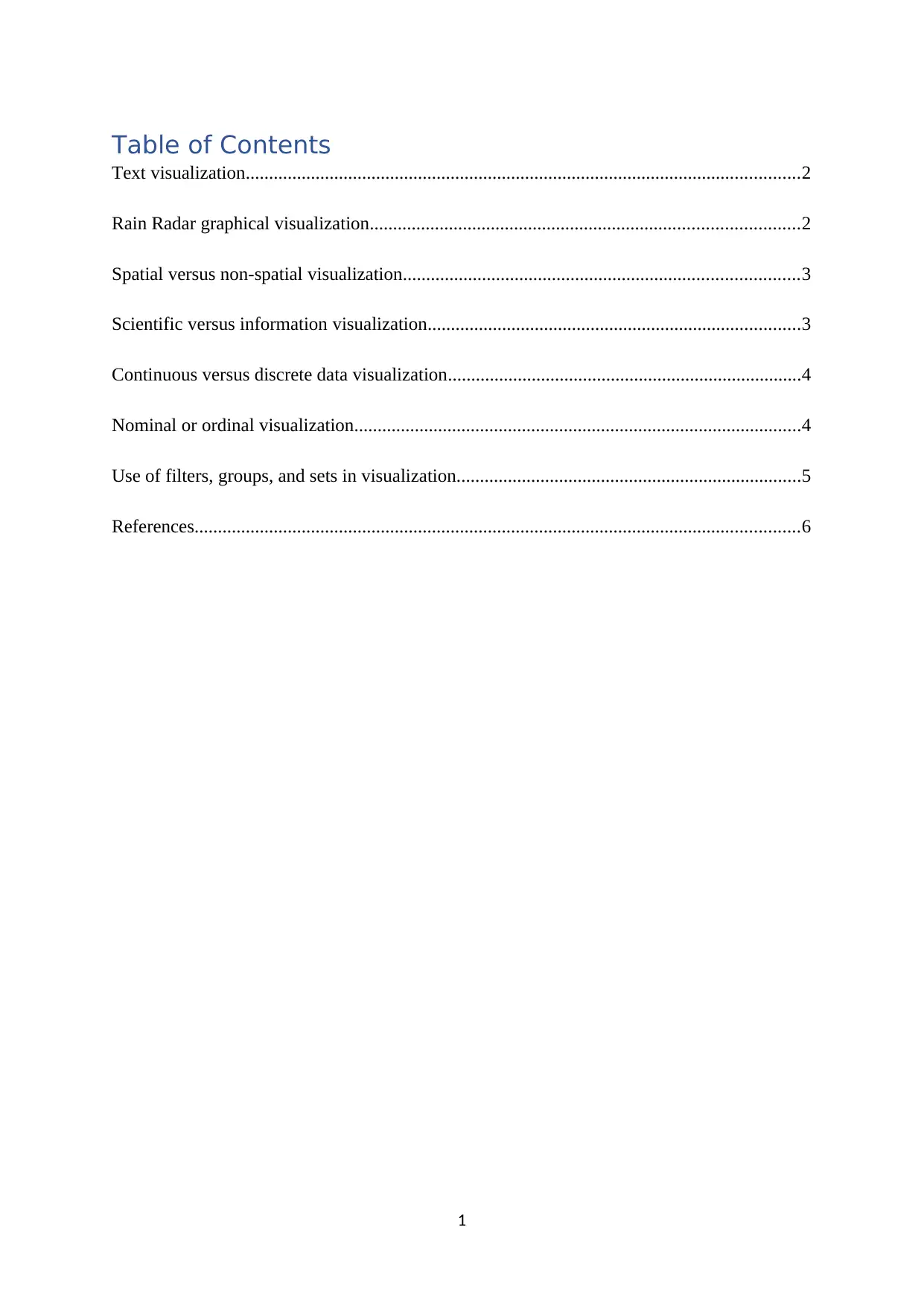
Table of Contents
Text visualization.......................................................................................................................2
Rain Radar graphical visualization............................................................................................2
Spatial versus non-spatial visualization.....................................................................................3
Scientific versus information visualization................................................................................3
Continuous versus discrete data visualization............................................................................4
Nominal or ordinal visualization................................................................................................4
Use of filters, groups, and sets in visualization..........................................................................5
References..................................................................................................................................6
1
Text visualization.......................................................................................................................2
Rain Radar graphical visualization............................................................................................2
Spatial versus non-spatial visualization.....................................................................................3
Scientific versus information visualization................................................................................3
Continuous versus discrete data visualization............................................................................4
Nominal or ordinal visualization................................................................................................4
Use of filters, groups, and sets in visualization..........................................................................5
References..................................................................................................................................6
1
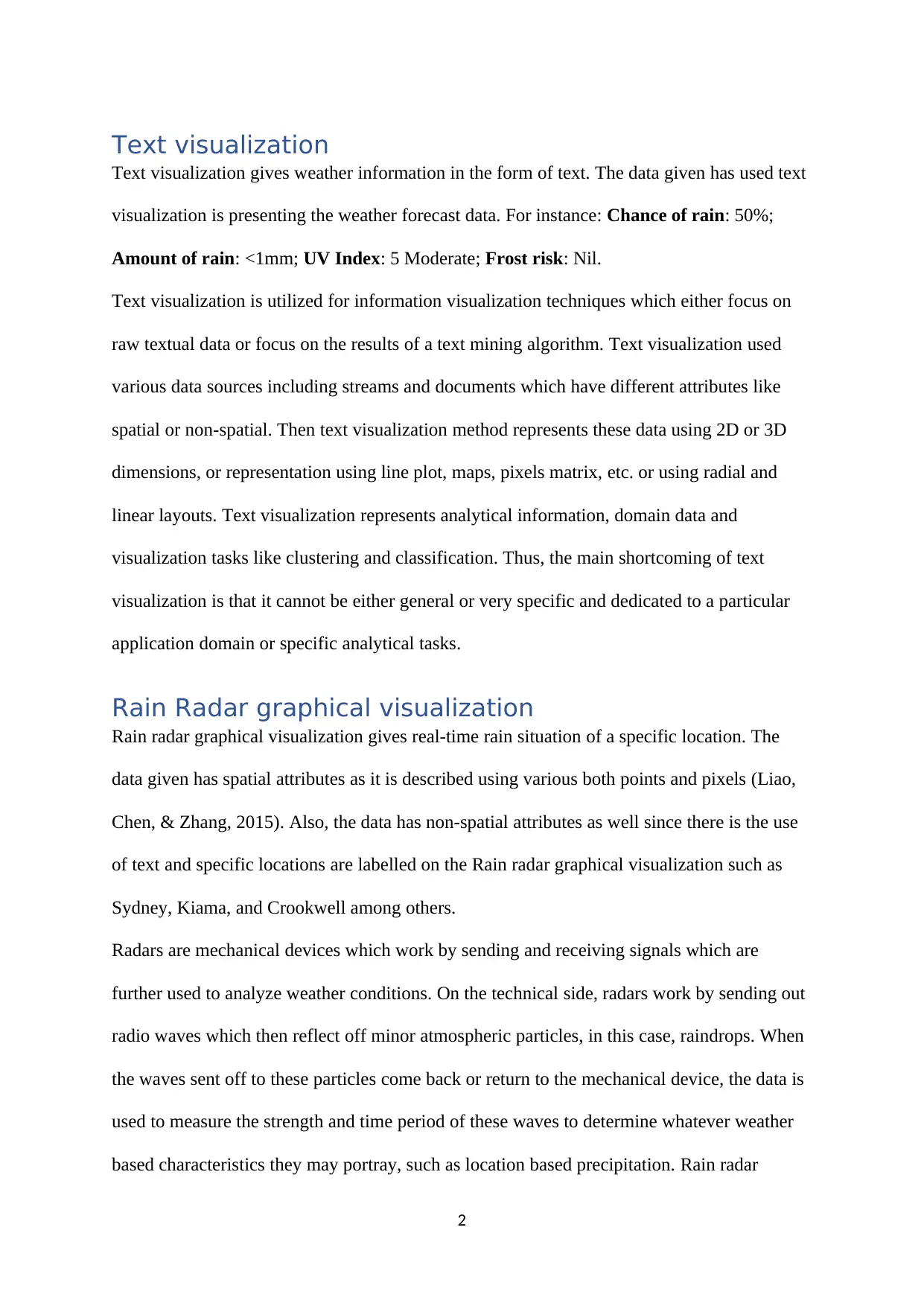
Text visualization
Text visualization gives weather information in the form of text. The data given has used text
visualization is presenting the weather forecast data. For instance: Chance of rain: 50%;
Amount of rain: <1mm; UV Index: 5 Moderate; Frost risk: Nil.
Text visualization is utilized for information visualization techniques which either focus on
raw textual data or focus on the results of a text mining algorithm. Text visualization used
various data sources including streams and documents which have different attributes like
spatial or non-spatial. Then text visualization method represents these data using 2D or 3D
dimensions, or representation using line plot, maps, pixels matrix, etc. or using radial and
linear layouts. Text visualization represents analytical information, domain data and
visualization tasks like clustering and classification. Thus, the main shortcoming of text
visualization is that it cannot be either general or very specific and dedicated to a particular
application domain or specific analytical tasks.
Rain Radar graphical visualization
Rain radar graphical visualization gives real-time rain situation of a specific location. The
data given has spatial attributes as it is described using various both points and pixels (Liao,
Chen, & Zhang, 2015). Also, the data has non-spatial attributes as well since there is the use
of text and specific locations are labelled on the Rain radar graphical visualization such as
Sydney, Kiama, and Crookwell among others.
Radars are mechanical devices which work by sending and receiving signals which are
further used to analyze weather conditions. On the technical side, radars work by sending out
radio waves which then reflect off minor atmospheric particles, in this case, raindrops. When
the waves sent off to these particles come back or return to the mechanical device, the data is
used to measure the strength and time period of these waves to determine whatever weather
based characteristics they may portray, such as location based precipitation. Rain radar
2
Text visualization gives weather information in the form of text. The data given has used text
visualization is presenting the weather forecast data. For instance: Chance of rain: 50%;
Amount of rain: <1mm; UV Index: 5 Moderate; Frost risk: Nil.
Text visualization is utilized for information visualization techniques which either focus on
raw textual data or focus on the results of a text mining algorithm. Text visualization used
various data sources including streams and documents which have different attributes like
spatial or non-spatial. Then text visualization method represents these data using 2D or 3D
dimensions, or representation using line plot, maps, pixels matrix, etc. or using radial and
linear layouts. Text visualization represents analytical information, domain data and
visualization tasks like clustering and classification. Thus, the main shortcoming of text
visualization is that it cannot be either general or very specific and dedicated to a particular
application domain or specific analytical tasks.
Rain Radar graphical visualization
Rain radar graphical visualization gives real-time rain situation of a specific location. The
data given has spatial attributes as it is described using various both points and pixels (Liao,
Chen, & Zhang, 2015). Also, the data has non-spatial attributes as well since there is the use
of text and specific locations are labelled on the Rain radar graphical visualization such as
Sydney, Kiama, and Crookwell among others.
Radars are mechanical devices which work by sending and receiving signals which are
further used to analyze weather conditions. On the technical side, radars work by sending out
radio waves which then reflect off minor atmospheric particles, in this case, raindrops. When
the waves sent off to these particles come back or return to the mechanical device, the data is
used to measure the strength and time period of these waves to determine whatever weather
based characteristics they may portray, such as location based precipitation. Rain radar
2
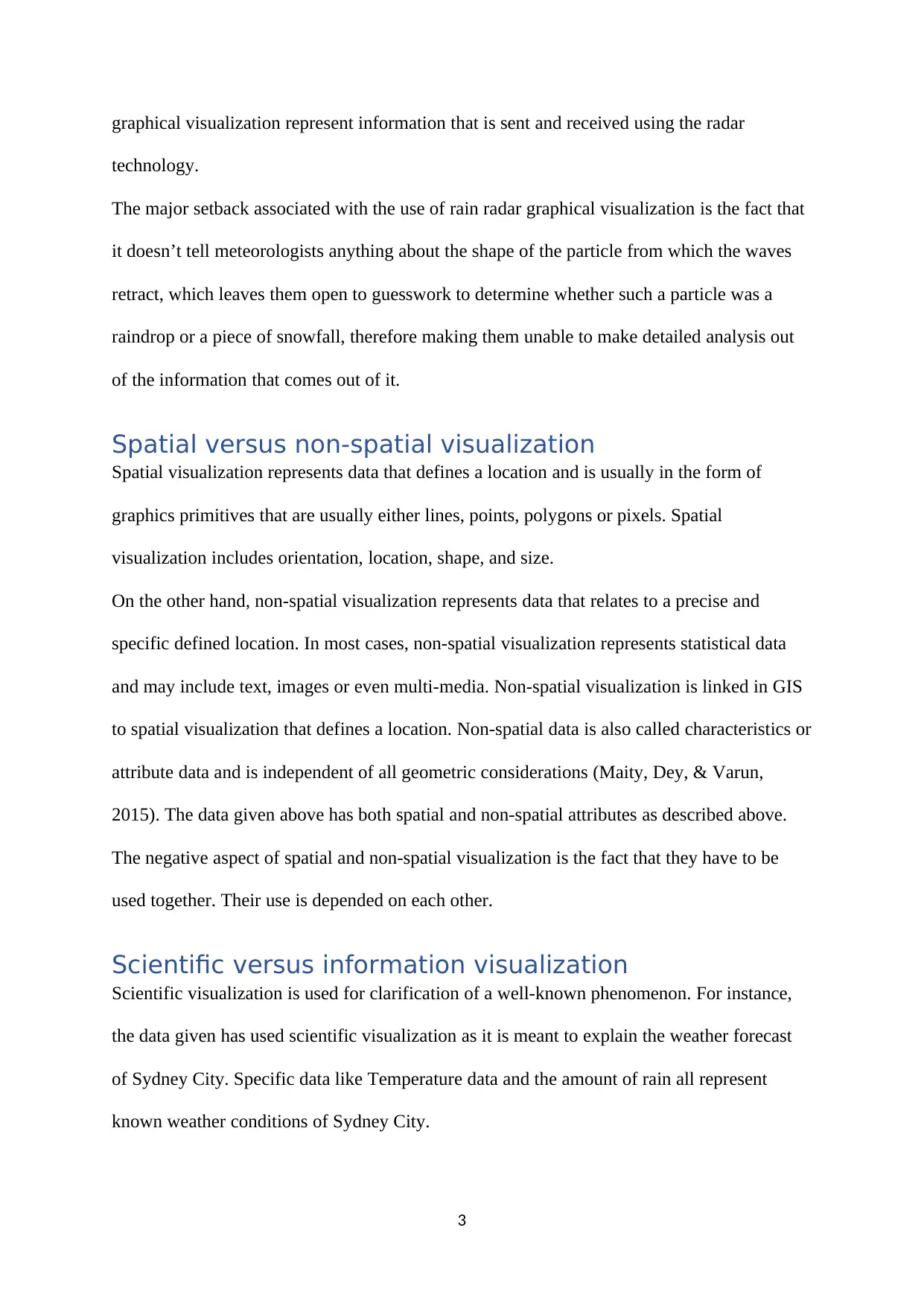
graphical visualization represent information that is sent and received using the radar
technology.
The major setback associated with the use of rain radar graphical visualization is the fact that
it doesn’t tell meteorologists anything about the shape of the particle from which the waves
retract, which leaves them open to guesswork to determine whether such a particle was a
raindrop or a piece of snowfall, therefore making them unable to make detailed analysis out
of the information that comes out of it.
Spatial versus non-spatial visualization
Spatial visualization represents data that defines a location and is usually in the form of
graphics primitives that are usually either lines, points, polygons or pixels. Spatial
visualization includes orientation, location, shape, and size.
On the other hand, non-spatial visualization represents data that relates to a precise and
specific defined location. In most cases, non-spatial visualization represents statistical data
and may include text, images or even multi-media. Non-spatial visualization is linked in GIS
to spatial visualization that defines a location. Non-spatial data is also called characteristics or
attribute data and is independent of all geometric considerations (Maity, Dey, & Varun,
2015). The data given above has both spatial and non-spatial attributes as described above.
The negative aspect of spatial and non-spatial visualization is the fact that they have to be
used together. Their use is depended on each other.
Scientific versus information visualization
Scientific visualization is used for clarification of a well-known phenomenon. For instance,
the data given has used scientific visualization as it is meant to explain the weather forecast
of Sydney City. Specific data like Temperature data and the amount of rain all represent
known weather conditions of Sydney City.
3
technology.
The major setback associated with the use of rain radar graphical visualization is the fact that
it doesn’t tell meteorologists anything about the shape of the particle from which the waves
retract, which leaves them open to guesswork to determine whether such a particle was a
raindrop or a piece of snowfall, therefore making them unable to make detailed analysis out
of the information that comes out of it.
Spatial versus non-spatial visualization
Spatial visualization represents data that defines a location and is usually in the form of
graphics primitives that are usually either lines, points, polygons or pixels. Spatial
visualization includes orientation, location, shape, and size.
On the other hand, non-spatial visualization represents data that relates to a precise and
specific defined location. In most cases, non-spatial visualization represents statistical data
and may include text, images or even multi-media. Non-spatial visualization is linked in GIS
to spatial visualization that defines a location. Non-spatial data is also called characteristics or
attribute data and is independent of all geometric considerations (Maity, Dey, & Varun,
2015). The data given above has both spatial and non-spatial attributes as described above.
The negative aspect of spatial and non-spatial visualization is the fact that they have to be
used together. Their use is depended on each other.
Scientific versus information visualization
Scientific visualization is used for clarification of a well-known phenomenon. For instance,
the data given has used scientific visualization as it is meant to explain the weather forecast
of Sydney City. Specific data like Temperature data and the amount of rain all represent
known weather conditions of Sydney City.
3
Secure Best Marks with AI Grader
Need help grading? Try our AI Grader for instant feedback on your assignments.
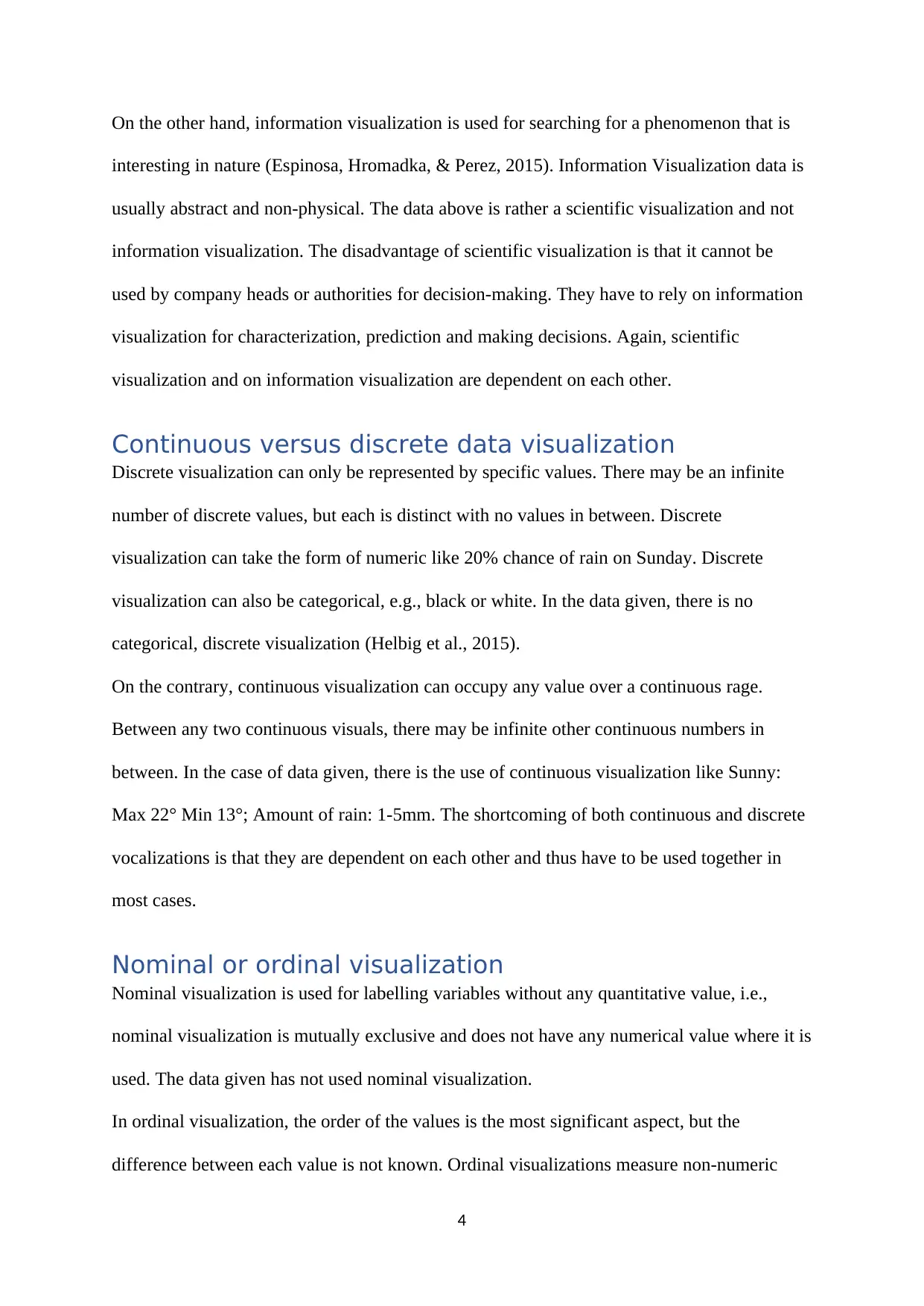
On the other hand, information visualization is used for searching for a phenomenon that is
interesting in nature (Espinosa, Hromadka, & Perez, 2015). Information Visualization data is
usually abstract and non-physical. The data above is rather a scientific visualization and not
information visualization. The disadvantage of scientific visualization is that it cannot be
used by company heads or authorities for decision-making. They have to rely on information
visualization for characterization, prediction and making decisions. Again, scientific
visualization and on information visualization are dependent on each other.
Continuous versus discrete data visualization
Discrete visualization can only be represented by specific values. There may be an infinite
number of discrete values, but each is distinct with no values in between. Discrete
visualization can take the form of numeric like 20% chance of rain on Sunday. Discrete
visualization can also be categorical, e.g., black or white. In the data given, there is no
categorical, discrete visualization (Helbig et al., 2015).
On the contrary, continuous visualization can occupy any value over a continuous rage.
Between any two continuous visuals, there may be infinite other continuous numbers in
between. In the case of data given, there is the use of continuous visualization like Sunny:
Max 22° Min 13°; Amount of rain: 1-5mm. The shortcoming of both continuous and discrete
vocalizations is that they are dependent on each other and thus have to be used together in
most cases.
Nominal or ordinal visualization
Nominal visualization is used for labelling variables without any quantitative value, i.e.,
nominal visualization is mutually exclusive and does not have any numerical value where it is
used. The data given has not used nominal visualization.
In ordinal visualization, the order of the values is the most significant aspect, but the
difference between each value is not known. Ordinal visualizations measure non-numeric
4
interesting in nature (Espinosa, Hromadka, & Perez, 2015). Information Visualization data is
usually abstract and non-physical. The data above is rather a scientific visualization and not
information visualization. The disadvantage of scientific visualization is that it cannot be
used by company heads or authorities for decision-making. They have to rely on information
visualization for characterization, prediction and making decisions. Again, scientific
visualization and on information visualization are dependent on each other.
Continuous versus discrete data visualization
Discrete visualization can only be represented by specific values. There may be an infinite
number of discrete values, but each is distinct with no values in between. Discrete
visualization can take the form of numeric like 20% chance of rain on Sunday. Discrete
visualization can also be categorical, e.g., black or white. In the data given, there is no
categorical, discrete visualization (Helbig et al., 2015).
On the contrary, continuous visualization can occupy any value over a continuous rage.
Between any two continuous visuals, there may be infinite other continuous numbers in
between. In the case of data given, there is the use of continuous visualization like Sunny:
Max 22° Min 13°; Amount of rain: 1-5mm. The shortcoming of both continuous and discrete
vocalizations is that they are dependent on each other and thus have to be used together in
most cases.
Nominal or ordinal visualization
Nominal visualization is used for labelling variables without any quantitative value, i.e.,
nominal visualization is mutually exclusive and does not have any numerical value where it is
used. The data given has not used nominal visualization.
In ordinal visualization, the order of the values is the most significant aspect, but the
difference between each value is not known. Ordinal visualizations measure non-numeric
4
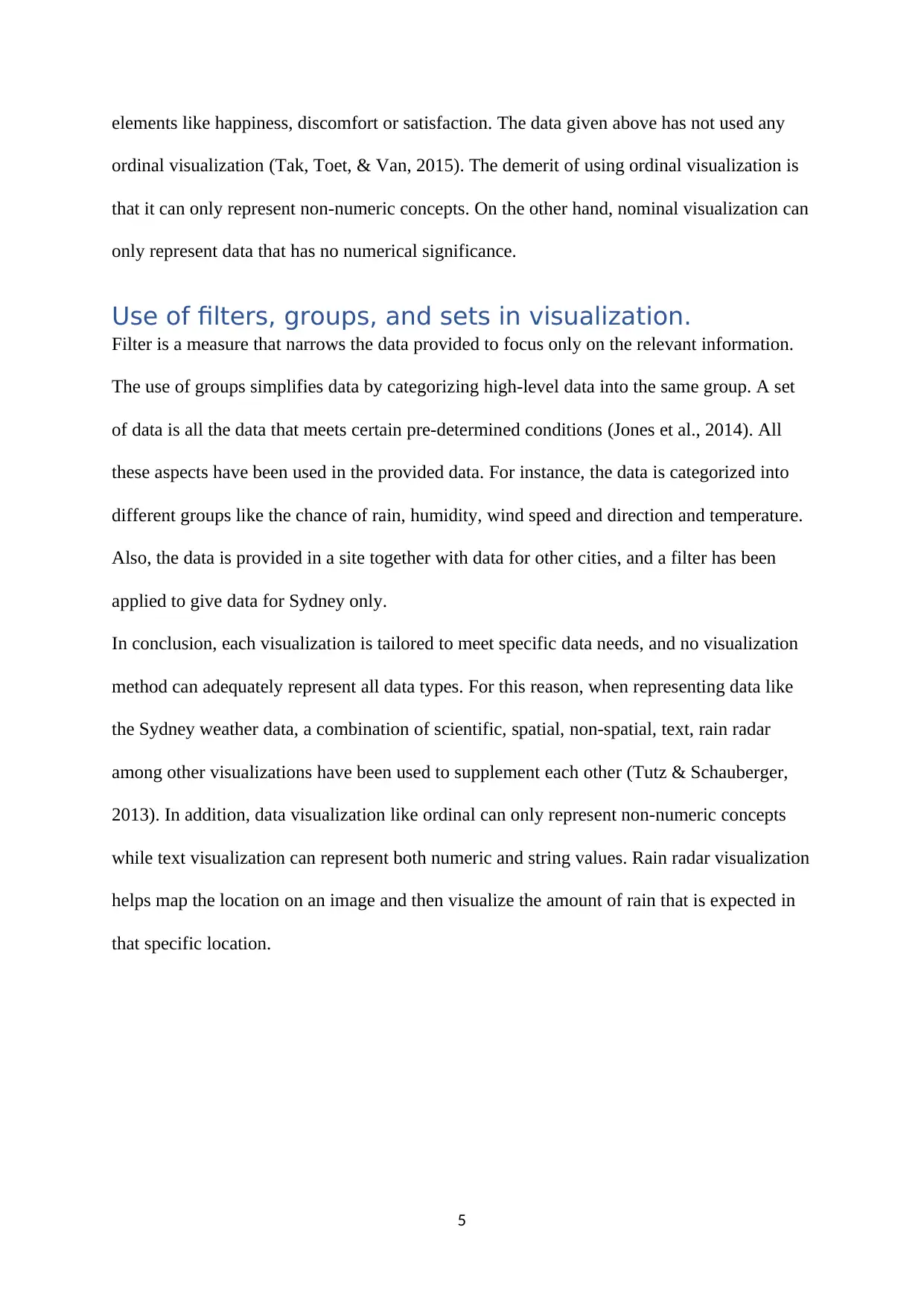
elements like happiness, discomfort or satisfaction. The data given above has not used any
ordinal visualization (Tak, Toet, & Van, 2015). The demerit of using ordinal visualization is
that it can only represent non-numeric concepts. On the other hand, nominal visualization can
only represent data that has no numerical significance.
Use of filters, groups, and sets in visualization.
Filter is a measure that narrows the data provided to focus only on the relevant information.
The use of groups simplifies data by categorizing high-level data into the same group. A set
of data is all the data that meets certain pre-determined conditions (Jones et al., 2014). All
these aspects have been used in the provided data. For instance, the data is categorized into
different groups like the chance of rain, humidity, wind speed and direction and temperature.
Also, the data is provided in a site together with data for other cities, and a filter has been
applied to give data for Sydney only.
In conclusion, each visualization is tailored to meet specific data needs, and no visualization
method can adequately represent all data types. For this reason, when representing data like
the Sydney weather data, a combination of scientific, spatial, non-spatial, text, rain radar
among other visualizations have been used to supplement each other (Tutz & Schauberger,
2013). In addition, data visualization like ordinal can only represent non-numeric concepts
while text visualization can represent both numeric and string values. Rain radar visualization
helps map the location on an image and then visualize the amount of rain that is expected in
that specific location.
5
ordinal visualization (Tak, Toet, & Van, 2015). The demerit of using ordinal visualization is
that it can only represent non-numeric concepts. On the other hand, nominal visualization can
only represent data that has no numerical significance.
Use of filters, groups, and sets in visualization.
Filter is a measure that narrows the data provided to focus only on the relevant information.
The use of groups simplifies data by categorizing high-level data into the same group. A set
of data is all the data that meets certain pre-determined conditions (Jones et al., 2014). All
these aspects have been used in the provided data. For instance, the data is categorized into
different groups like the chance of rain, humidity, wind speed and direction and temperature.
Also, the data is provided in a site together with data for other cities, and a filter has been
applied to give data for Sydney only.
In conclusion, each visualization is tailored to meet specific data needs, and no visualization
method can adequately represent all data types. For this reason, when representing data like
the Sydney weather data, a combination of scientific, spatial, non-spatial, text, rain radar
among other visualizations have been used to supplement each other (Tutz & Schauberger,
2013). In addition, data visualization like ordinal can only represent non-numeric concepts
while text visualization can represent both numeric and string values. Rain radar visualization
helps map the location on an image and then visualize the amount of rain that is expected in
that specific location.
5
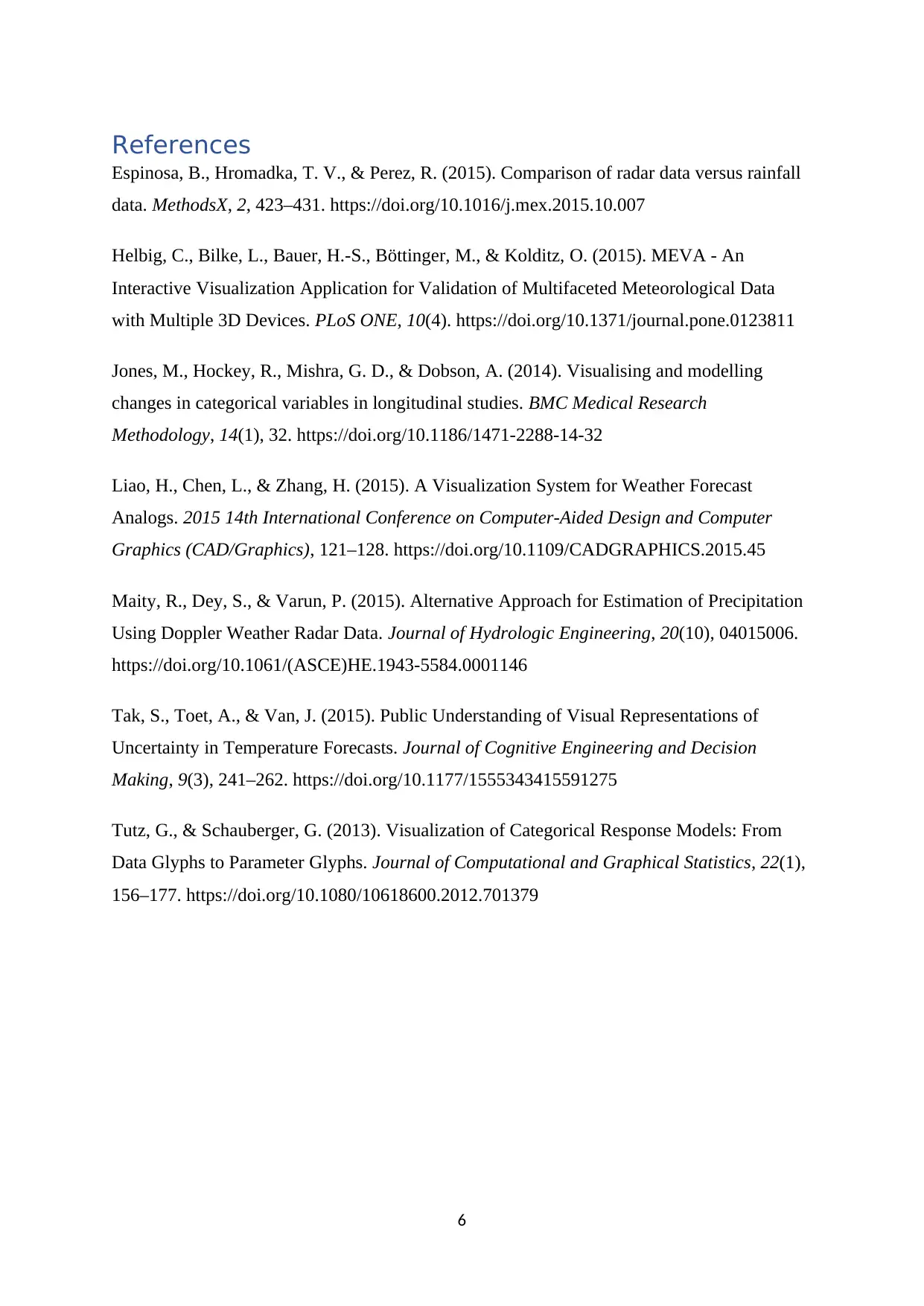
References
Espinosa, B., Hromadka, T. V., & Perez, R. (2015). Comparison of radar data versus rainfall
data. MethodsX, 2, 423–431. https://doi.org/10.1016/j.mex.2015.10.007
Helbig, C., Bilke, L., Bauer, H.-S., Böttinger, M., & Kolditz, O. (2015). MEVA - An
Interactive Visualization Application for Validation of Multifaceted Meteorological Data
with Multiple 3D Devices. PLoS ONE, 10(4). https://doi.org/10.1371/journal.pone.0123811
Jones, M., Hockey, R., Mishra, G. D., & Dobson, A. (2014). Visualising and modelling
changes in categorical variables in longitudinal studies. BMC Medical Research
Methodology, 14(1), 32. https://doi.org/10.1186/1471-2288-14-32
Liao, H., Chen, L., & Zhang, H. (2015). A Visualization System for Weather Forecast
Analogs. 2015 14th International Conference on Computer-Aided Design and Computer
Graphics (CAD/Graphics), 121–128. https://doi.org/10.1109/CADGRAPHICS.2015.45
Maity, R., Dey, S., & Varun, P. (2015). Alternative Approach for Estimation of Precipitation
Using Doppler Weather Radar Data. Journal of Hydrologic Engineering, 20(10), 04015006.
https://doi.org/10.1061/(ASCE)HE.1943-5584.0001146
Tak, S., Toet, A., & Van, J. (2015). Public Understanding of Visual Representations of
Uncertainty in Temperature Forecasts. Journal of Cognitive Engineering and Decision
Making, 9(3), 241–262. https://doi.org/10.1177/1555343415591275
Tutz, G., & Schauberger, G. (2013). Visualization of Categorical Response Models: From
Data Glyphs to Parameter Glyphs. Journal of Computational and Graphical Statistics, 22(1),
156–177. https://doi.org/10.1080/10618600.2012.701379
6
Espinosa, B., Hromadka, T. V., & Perez, R. (2015). Comparison of radar data versus rainfall
data. MethodsX, 2, 423–431. https://doi.org/10.1016/j.mex.2015.10.007
Helbig, C., Bilke, L., Bauer, H.-S., Böttinger, M., & Kolditz, O. (2015). MEVA - An
Interactive Visualization Application for Validation of Multifaceted Meteorological Data
with Multiple 3D Devices. PLoS ONE, 10(4). https://doi.org/10.1371/journal.pone.0123811
Jones, M., Hockey, R., Mishra, G. D., & Dobson, A. (2014). Visualising and modelling
changes in categorical variables in longitudinal studies. BMC Medical Research
Methodology, 14(1), 32. https://doi.org/10.1186/1471-2288-14-32
Liao, H., Chen, L., & Zhang, H. (2015). A Visualization System for Weather Forecast
Analogs. 2015 14th International Conference on Computer-Aided Design and Computer
Graphics (CAD/Graphics), 121–128. https://doi.org/10.1109/CADGRAPHICS.2015.45
Maity, R., Dey, S., & Varun, P. (2015). Alternative Approach for Estimation of Precipitation
Using Doppler Weather Radar Data. Journal of Hydrologic Engineering, 20(10), 04015006.
https://doi.org/10.1061/(ASCE)HE.1943-5584.0001146
Tak, S., Toet, A., & Van, J. (2015). Public Understanding of Visual Representations of
Uncertainty in Temperature Forecasts. Journal of Cognitive Engineering and Decision
Making, 9(3), 241–262. https://doi.org/10.1177/1555343415591275
Tutz, G., & Schauberger, G. (2013). Visualization of Categorical Response Models: From
Data Glyphs to Parameter Glyphs. Journal of Computational and Graphical Statistics, 22(1),
156–177. https://doi.org/10.1080/10618600.2012.701379
6
1 out of 7
Your All-in-One AI-Powered Toolkit for Academic Success.
+13062052269
info@desklib.com
Available 24*7 on WhatsApp / Email
![[object Object]](/_next/static/media/star-bottom.7253800d.svg)
Unlock your academic potential
© 2024 | Zucol Services PVT LTD | All rights reserved.

